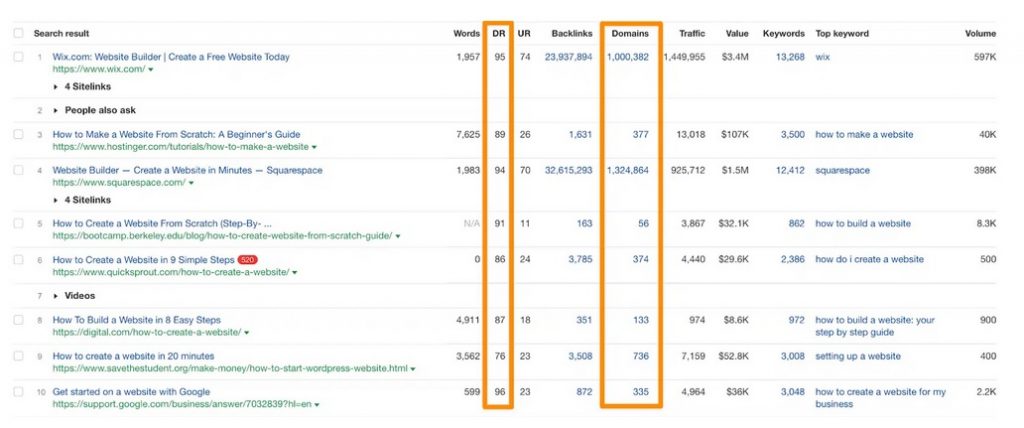Link building is an essential part of any successful digital marketing strategy. It’s the process of acquiring hyperlinks from other websites to your own, with the goal of increasing traffic, visibility, and ultimately, search engine rankings.
However, despite its importance, many brands fail at link building. In this post, we’ll explore the top five mistakes that brands make when it comes to link building, and offer tips on how to avoid them.
Mistake #1: Think you don’t have to be proactive about building links
In low-to-no competition niches such as pet food, link building for long-tail keywords may not be necessary. However, the lack of competition often translates to low profitability. In contrast, highly competitive niches such as finance are lucrative but require effective link building strategies to succeed.
To illustrate, we compiled a list of 1,000 popular finance keywords and analyzed their Ahrefs data by keyword difficulty range and referring domains per page for the top search engine results pages.
The results showed a bell curve distribution. While some keywords are less difficult and have fewer referring domains, the majority fall in the middle with a keyword difficulty range of approximately 30-60 and 50-200 referring domains per page.

This trend is consistent with other similar industries, highlighting the importance of implementing successful link building tactics to compete and succeed in highly competitive and profitable niches.
This is because in order to compete in a profitable industry, you need to have a substantial number of high-quality backlinks per page. This number typically ranges from 50-200. If you are unable to attract or acquire this number of external links for each page or article you want to rank, you will never be able to compete effectively.
In highly competitive industries, a combination of quality and quantity is required to succeed. For instance, a popular commercial keyword like “how to make a website” has search engine results pages (SERPs) dominated by sites with high domain ratings (DR) ranging from 76 to 90+. Additionally, these sites typically have several hundred or more referring domains per page on average, making it difficult to compete without similar link building strategies.

Scaling both the quality and quantity of links is necessary to compete in industries with a high level of competition. Focusing solely on one without the other is insufficient in industries with fierce competition.
Mistake #2: Leaving links to chance compared to systemizing success
Many average and small-scale marketers believe that backlinks will appear out of thin air without putting in any effort. The idea of “if you build it, they will come” is a naive and simplistic approach to link building. While this may work for large companies such as HubSpot, Coca-Cola, or American Express, it is not a realistic expectation for the majority of businesses.
For instance, let’s consider the commercial keyword “best project management software.” According to Ahrefs, approximately 273 links are needed to compete for the first page of search engine results. However, this estimate is subject to variation based on factors such as link quality, domain rating, and topical authority. Nevertheless, the underlying point remains valid.

Expecting a large number of links to materialize on a heavily commercial product comparison page is unrealistic. Instead of attempting to purchase links, a better approach is to identify what other potential link partners might require from you in exchange.
Usually, this can be boiled down to three things: money, content/assets, or visibility. For example, content sites that require advertisers, brands that need creative assets, or influencers seeking to expand their audience can all be potential link partners.
To put it differently, it is important to determine your own assets or areas of expertise that you can utilize to assist others before requesting a reciprocal gesture. By doing so, you will eventually obtain a significant number of backlinks on a regular basis.
Mistake #3: Using the wrong link building tactics for the wrong kinds of links
At this point, it is clear that link building requires effort and cannot be left to chance. However, the issue is that many marketers tend to use ineffective link-building tactics at the wrong time. This leads to limited success, a waste of resources, and ultimately hinders their financial growth.
One such tactic is cold outreach, which may work for lower DR (i.e., smaller) sites in certain industries but is less likely to succeed with high DR (i.e., big) sites. To build links with such sites, warm tactics, a referral, or offering something of value may be necessary.
To sum it up, the approach to link building depends on the domain rating of the websites you’re targeting.
- If you’re in the under 30 range, it’s likely that you’ll receive natural links if you create quality content.
- For sites with a DR of around 30-60, cold outreach can be effective in acquiring links. For DRs between 60-90, it’s important to provide creative assets or content, or engage in mutually beneficial partnerships.
- For DRs above 90, it’s necessary to have personal relationships, a strong network, or a large budget for sponsorships or donations.
While these guidelines may not be universally applicable, they are generally accurate for most competitive spaces.

Mistake #4: Scatterbrained link building vs. doubling down on 2-3 scalable ones
The format of list posts has been around for a long time and has been a classic. However, marketers have ruined it by creating extensive list posts that are essentially useless.
These “1,093,394,560 link building tactics” posts are misguided and give a false sense of belief. In reality, you only need 2-3 legitimate link building tactics to start and then you should focus on doubling down on those tactics as much as possible.
For example, if you hit a link building goldmine with proprietary data and linkable assets, you should continue producing new related proprietary data and linkable assets instead of switching gears to classic 404 or broken link building outreach emails.
Winning in link building is not about chasing overplayed or cliché tactics, but about focusing on what works and consistently producing high-quality content.
Mistake #5: Prioritizing the wrong pages at the wrong times
It may not be fair, but big brands are able to rank for a wider range of topics with fewer links due to their established topical authority, content quality, and internal linking. Instead of complaining, it’s important to learn from their strategies.
One key aspect is how they prioritize link building efforts for different pages on their site. For instance, building brand recognition should always be a top priority for the homepage, while commercial pages often require more creative link building tactics.
Lastly, focus on creating high-quality pillar pages for competitive queries and use internal linking to drive traffic to related child pages.
The list provided above does not include links to long-tail pages which are typically top-of-funnel (TOFU) type pages. This is because big brands prioritize resource allocation towards the three categories mentioned above and can use internal links to rank longer-tail, less commercial content. However, for new or small sites, focusing on long-tail pages is a good starting point.
Nonetheless, professionals move beyond this stage and implement high quantity and quality link building strategies for key pages to scale faster than amateurs.
Link building is a difficult task but can yield significant results if executed properly, which distinguishes the experts from the novices who commonly commit the same errors.

Bottom Line
Many people have misunderstandings about link building. Some believe it is illegal, which is not true, while others think they don’t need it, which is also false. The reality lies somewhere in between, and this is where professionals excel. They know how to leverage the right tactics at the right time, from the right websites, to obtain the right types of links that will benefit their site’s specific pages.
Professionals don’t rely on tricks or gimmicks or hope for success like amateurs. They have a deep understanding of the process and how to make it work consistently.
The post Top 5 Mistakes: The Reasons Why Most Brands Fail at Link Building appeared first on Creativ Digital.
from Creativ Digital https://ift.tt/J9V3Qhv
No comments:
Post a Comment